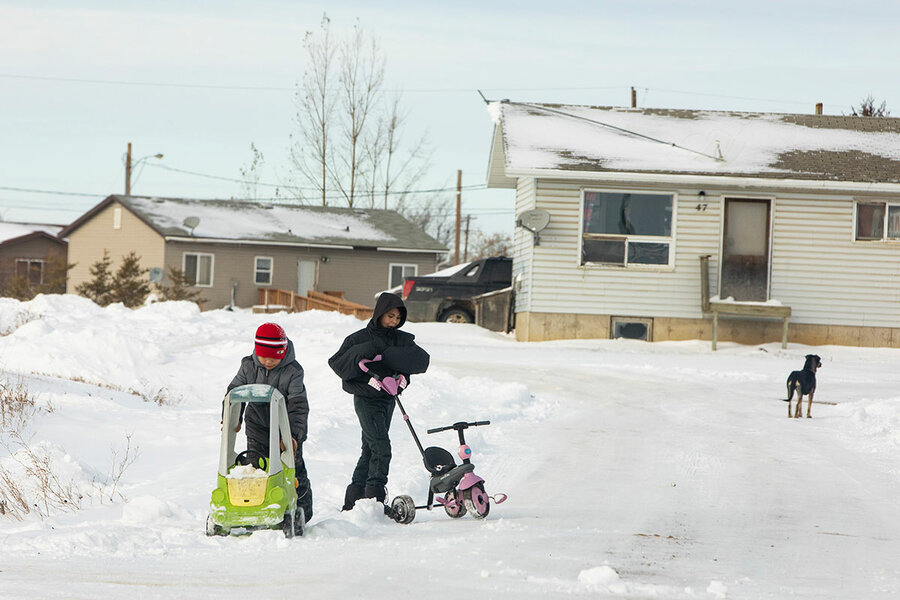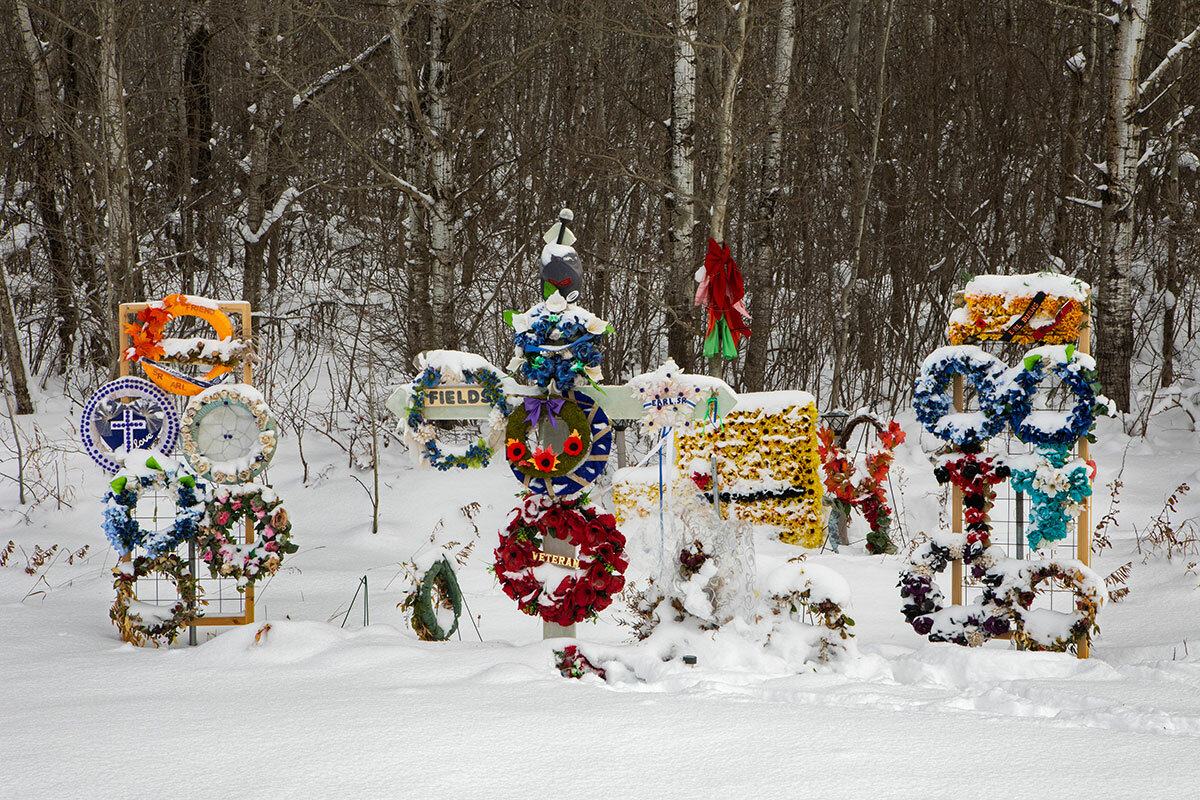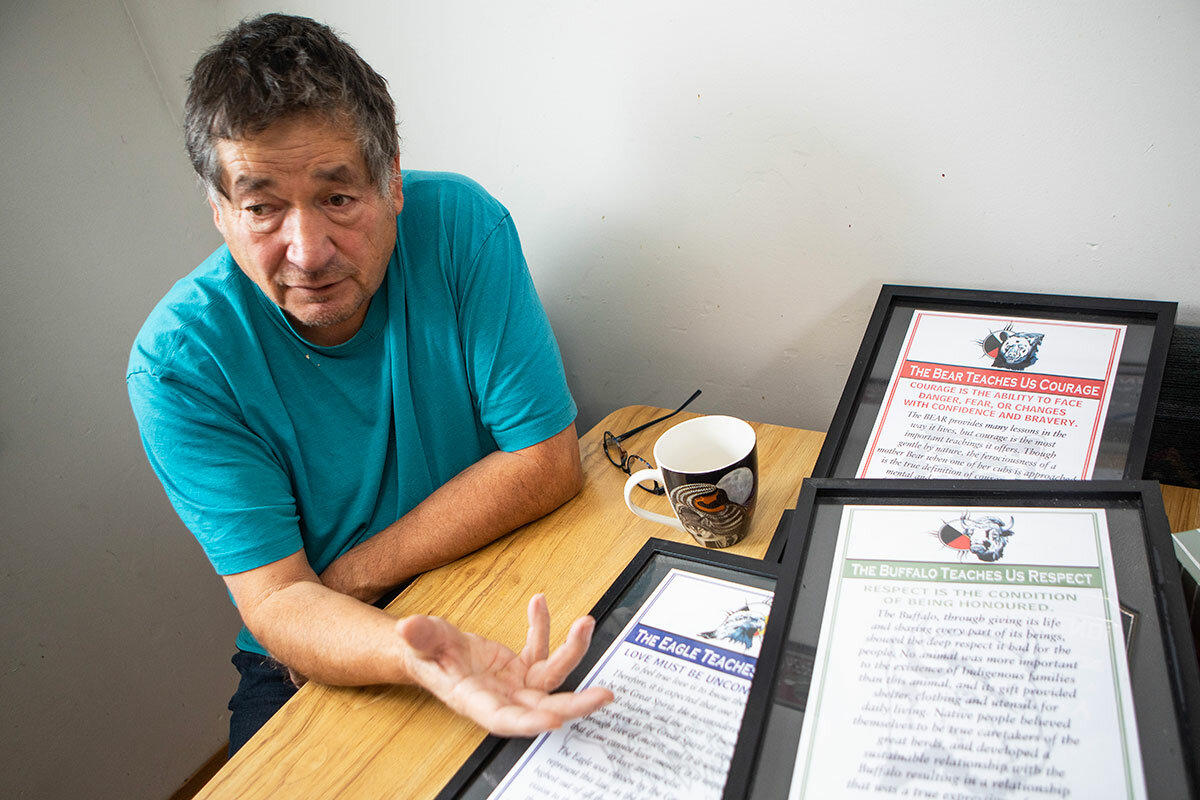In Canada, calls mount for more Indigenous police forces
Loading...
| James Smith Cree Nation, Saskatchewan
Annie Sanderson had grown to love the quiet of her home, set on the bend of a gravel road deep in the prairies, far from the heart of her reserve.
But when the James Smith Cree Nation reserve witnessed one of Canada’s deadliest mass homicides – a stabbing rampage Sept. 4th in this remote region – being set apart took on new meaning.
It took the police nearly 40 minutes to reach the reserve from their base 25 miles away. Ultimately the killer, a member of the community, visited 13 different sites, slaying 11 people, including his brother, and wounding 18.
Why We Wrote This
A story focused onA mass killing on an Indigenous reserve in Canada prompts a question: Might an autonomous Indigenous police force have prevented the tragedy?
“When all that happened, we really felt so isolated,” says Ms. Sanderson.
Now Indigenous communities here in Saskatchewan, and across Canada, have renewed a push for more community-oriented policing, including their own self-administered forces. That, they say, holds out the best hope of protecting isolated communities grappling with issues such as poverty and addiction that are compounded by generations of state-imposed violence.
The drive also reflects a broader move in Canada toward Indigenous autonomy. “Policing, for a lot of these communities, is one of the most visible signs of self-determination,” says Lennard Busch, executive director of the First Nations Chiefs of Police Association.
The Prince Albert Grand Council, to which the James Smith Cree Nation belongs, signed a letter of intent recently with federal and provincial governments to explore new ways of delivering police services. At the same time, Canada is mulling legislation that would classify Indigenous policing as an “essential service,” the way other emergency services are categorized. That would help ensure more generous and more consistent funding.
The Mounties’ mixed legacy
Violent crime in Indigenous communities is growing. A 2022 government report showed rates nine times higher in primarily Indigenous communities than non-Indigenous ones.
In the prairies, many Indigenous reserves are policed by the Royal Canadian Mounted Police (RCMP), which marks its 150th anniversary next year. While the “Mounties” are a popular global brand, they originated as a colonial force to settle the West, and they have enacted some of Canada’s most violent policies against Indigenous residents.
Though Indigenous peoples make up just 5% of the Canadian population, they comprised one third of victims shot to death by RCMP officers between 2007 and 2017.
Indigenous policing got its start in 1991 as part of the First Nations and Inuit Policing Program. Under that model, the RCMP dedicates officers to Indigenous communities, instead of rotating them in and out, or communities run their own self-administered forces. Today there are 36 autonomous forces, including one in Saskatchewan, of which Mr. Busch became the police chief after a long career in the RCMP. But a lack of funding has hampered their growth, he says.
Kimberly Murray, appointed this year as the independent special interlocutor for missing children and unmarked graves and burial sites, says federal legislation to classify Indigenous policing as “essential” would turn it from a “program” into an emergency service just like any other community relies upon.
Self-determined policing, says Ms. Murray, would protect communities better than “outsiders coming in and imposing colonial laws.” Officers in autonomous police forces “are taught about treaty obligations, treaty rights, and the responsibilities of individuals in the family according to Indigenous laws,” she points out. They enjoy the trust of communities in the ongoing search for unmarked graves at former residential schools, and they take a more informed and nuanced view of land disputes.
They understand the issues, and do not just see “protesters trying to stop a pipeline,” Ms. Murray says.
“We’re going to be warriors again”
Darryl Burns sits at his kitchen table in the tranquil house he shares with Ms. Sanderson – photos of their grandchildren throughout. He lost his younger sister, Gloria, in September’s rampage.
He and his late sister worked as crisis counselors for James Smith Cree Nation; she was killed as she responded to victims’ calls. “I have to come to terms with my own feelings, my own anger, my own resentments,” says Mr. Burns. “We have good days. We have really good days. And all of a sudden, this. Boom.”
He supports the efforts spearheaded by the Prince Albert Grand Council, which includes 12 First Nations, because the challenges extend well beyond his own reserve. But they also run much deeper than policing, he says. Addiction and drug-fueled violence have grown too prevalent – the perpetrator had a history of both – and he sees the solution in reclamation of Indigenous beliefs and values.
The government appears to support that idea. Canadian Prime Minister Justin Trudeau visited James Smith Cree Nation last month to announce $62.5 million (Canadian; U.S.$45.7 million) in government programs, some of which will pay for mental health and substance abuse services.
“We can make a decision to start healing and start leading our people on a good path,” Mr. Burns says. “That’s the vision I have for us, not only in James Smith but across North America, Canada, and the United States. That we’re going to be warriors again, we’re not going to be survivors.”
“Unless we address the trauma and the hurt and the pain and the addictions,” he adds, “I don’t know if we can ever feel safe.”
According to federal statistics, Saskatchewan has the highest murder rate of all the Canadian provinces. It also has the highest per capita homicide rate among Indigenous people: 13 times higher than that for non-Indigenous.
Hilary Peterson, a lecturer in law at the University of Saskatchewan, says the justice system is broken for Indigenous people, beset by systemic racism. “The reason why policing is so important,” she suggests, is that the police are the front line of that justice system, and “it’s often the place where (racism) starts.”
Not that Indigenous police officers would always be a panacea, cautions Doug Cuthand, a newspaper columnist and documentary film maker in Saskatoon. Being close to a reserve and its residents can cut both ways, he points out. An Indigenous officer would know a reserve’s issues intimately. On the other hand, “it can be very difficult for a policeman to ... police the reserve because you are related to so many people,” he says.
“But there is a need for a homegrown police force,” he adds. “And it has to be put together by our own people.”









